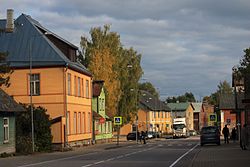Abja-Paluoja | |
|---|---|
 Main street in Abja-Paluoja | |
| Coordinates: 58°07′33″N25°21′31″E / 58.12583°N 25.35861°E | |
| Country | Estonia |
| County | Viljandi County |
| Municipality | Mulgi Parish |
| Town status | 1993 |
| Population (2024) [1] | |
• Total | 1,056 |
| • Rank | 44th |
| Time zone | UTC+2 (EET) |
Abja-Paluoja is a town in Mulgi Parish, Viljandi County, in southern Estonia. Abja-Paluoja got the town status and became a separate urban municipality in 1993.








